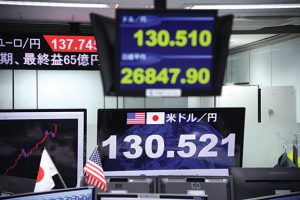Bloomberg
The yen’s plunge to a 20-year low threatens to leave it significantly weaker for years to come, shaking up global money flows and undermining Japan’s efforts to get its fragile economy back on track.
The speed of the decline — it’s slumped 11% against the dollar in seven weeks — has caught policy makers off guard and exposed divisions between a central bank intent on stoking inflation and a government facing a backlash over rising prices.
Currency trading has gone into overdrive while other parts of the financial markets are counting the costs. Companies have slashed sales of yen-denominated bonds they depend on to fund operations and the returns that Tokyo-listed stocks offer international investors have plunged far into the red in dollar terms.
The sell-off began in earnest around March 10, when the US reported the highest inflation in 40 years, increasing expectations for the Federal Reserve to raise rates aggressively while the Bank of Japan stands still.
The yen tumbled through the key 130 level versus the dollar, causing alarm at the Finance Ministry, after Governor Haruhiko Kuroda doubled down on his ultra-easy settings with plans for fixed-rate bond purchases every day to keep yields in check.
But it’s also clear that forces beyond differences in interest rates have intensified the currency’s rout. When the Fed embarked on its last hiking cycle through late 2018, the yen didn’t see a comparable decline.
This slump — which has coincided with Russia’s invasion of Ukraine — has spurred global fund managers to question the long-held view of the yen as a haven in times of trouble. If they’re right, more money may head to places like North America, Europe and China during future crises.
“What sometimes appears to be a short-term move can in fact signal a deeper, more essential trend,†said Taku Ito, chief fund manager at Nissay Asset Management Corp. “People have been saying that the yen is falling because of interest rate differentials, but it may actually reflect a weakening of the Japanese economy.â€
The war in Ukraine and the impact of the pandemic have heaped more pressure on Japan, laying bare an economy that’s struggling to regain its vigor despite nearly a decade of effort through Abenomics.
Real gross domestic product will tick up to 2% this year but begin sliding again in 2023, before hitting just 0.8% in 2024, according to Bloomberg Economics. And while consumer price inflation may briefly reach around 2% at some point this year, the BOJ doesn’t see annual inflation hitting that level in forecasts out to March 2025.
Rising food and energy costs are pushing up the country’s import bill and its trade balance has been in deficit for eight consecutive months. The consumer price index accelerated to 1.2% last month while a gauge that strips out food and energy costs dropped 0.7%.
Consumers who waited for wage rises that never came are unwilling to pay higher prices. The central bank is holding out for domestic demand to pick up and businesses that cater to Japan’s home market are caught in the middle.
Meanwhile, exporters like Toyota Motor Corp. are seeing raw materials costs rise but get less benefit than they once did from a lower yen, having increased production offshore as the population shrinks at home.
“The weak economy means investment won’t flow into Japan and Japanese companies won’t invest inside the nation,†said Takatoshi Ito, a professor at Columbia University’s School of International and Public Affairs. “The moves in the yen haven’t diverged from economic fundamentals.â€
His assessment helps explain why Japan hasn’t gone into the market to stem the drop by selling dollars for yen, and why it can’t expect any support from its trading partners if it does. Despite more than $1.4 trillion of foreign currency reserves — a hoard second only to China’s — policy makers have confined themselves to verbal intervention.
The jawboning came again on Thursday, with an official from the Finance Ministry saying recent moves warrant extreme concern and that appropriate actions will be taken if needed. The comments had minimal affect on the currency.
With daily trading in excess of $6.6 trillion, foreign exchange is the world’s biggest financial market and too big for Japan to fight on its own with any hope of success.
An inflation-adjusted measure of the yen’s strength against a basket of currencies shows it in broad decline since the mid-1990s, around the time Japan’s economic bubble burst. It’s now at levels last seen half a century ago, when the dollar’s convertibility to gold ended, ushering in a new era for foreign exchange markets.
 The Gulf Time Newspaper One of the finest business newspapers in the UAE brought to you by our professional writers and editors.
The Gulf Time Newspaper One of the finest business newspapers in the UAE brought to you by our professional writers and editors.
